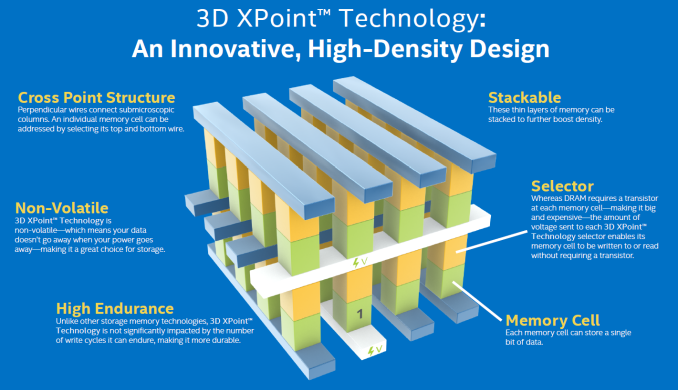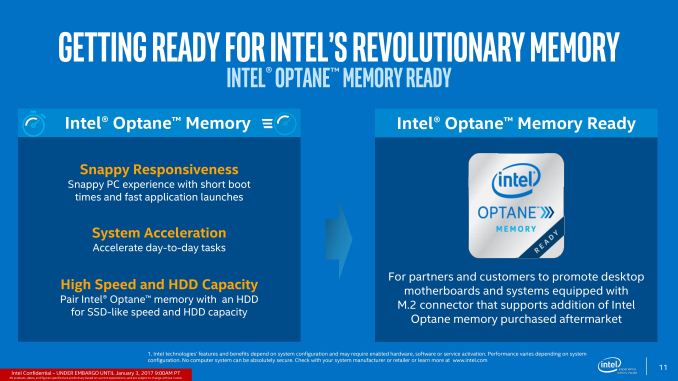Intel Launches 7th Generation Kaby Lake: 15W/28W with Iris, 35-91W Desktop and Mobile Xeon
by Ian Cutress on January 3, 2017 12:01 PM ESTOptane Memory: Support for Intel 3D XPoint
For our regular readers, 3D XPoint will be well known, but for everyone else here’s a quick recap. One of the goals in the memory industry is to create something with the speed of DRAM but persistent, such that the data is saved when the power is switched off. DRAM uses power to refresh data, but is a bulk-source of data movement for software. A lot of the speedup behind software is the speed behind memory accesses, or the ability to have data closer to the core when needed, so having a large, close, non-volatile memory set can be a big help in both performance and power consumption. In order to create non-volatile memory like this, several players have spent the best part of a decade creating new materials and new paradigms to get something that works. Intel (and Micron) formally announced their 3D XPoint solution over a year ago, allowing for a bit-level addressable matrix of non-volatile memory, however no products have formally been announced.
Intel intends to create three levels of 3D XPoint, suitable for different parts of the storage chain:
#1 - Storage (‘Optane SSD’): 120GB+ of SSD like NVMe storage
#2 - Storage Caching (‘Optane Memory’): 16-32GB of HDD Caching storage
#£ - DRAM (‘Optane DRAM’ ?): ?GB of DRAM, DDR4-pin compatible
The first two in that list have been defined, although the use of the term ‘Memory’ to define a storage cache is a little odd. Intel has stated in briefings that ‘Optane Memory’ is different to ‘Optane SSD’, and no exact word yet on how the 3D XPoint DRAM product will be named.
We saw a pair of the Optane SSD evaluation drives at IDF. These are drives that Intel hands out to large partners and OEMs to help configure future products or optimize software, and we were told these were early-production 140GB drives which may or may not represent what’s coming to market. Unfortunately aside from a few images of a heatsink several inches away, we were unable to look any deeper in to the design at the time.
Optane Memory, as announced through the recent Lenovo announcement, forms the brand name for a series of caching drives. We’ve had caching drives before, when SSDs were coming to the market and a combination of Intel RST, an mSATA drive and a spinning HDD meant that some elements of the storage were cached, affording a higher rate of performance over a regular HDD. The same concept applies here, with the 16GB Optane Memory drives acting as a cache for certain elements of the HDD use case enabling faster speeds when needed. We are told that this requires an update to Intel RST, and that Optane Memory will only work on Kaby Lake and up with a 200-series chipset (as in, you can’t use it with a 200-series chipset and Skylake, for example). The benefits of having Optane as a cache over a regular SSD are unclear at this point, aside from the fact that Optane will be under NVMe and use PCIe lanes – Billy Tallis, our SSD editor, has written a piece on the situation which is worth a read.
One thing that Intel mentioned during our Kaby Lake briefings is that ‘Optane Memory’ is different from ‘Optane SSD’, which could lead one to believe that ‘Optane Memory’, as a caching drive, cannot be used as an SSD. The original caching of an mSATA drive was almost like a hybrid RAID setup, and the mSATA drive could still be used as an SSD if it was configured that way. Because Intel is giving this a different naming system, it might stand to reason that the Optane caching drive cannot be used as a separate SSD in itself. Intel also stated that it will be later in the first half of 2017 before these drives are available as a separate purchase.
As of right now, only Lenovo has announced laptops with Optane Memory installed, however we expect several more vendors to announce products over the next few weeks unless Lenovo has initial exclusivity. So while Optane Memory is an advertised feature of Kaby Lake and the 200-series chipsets, it is one that users will have to wait to get to grips with, if relevant at all.












43 Comments
View All Comments
Lolimaster - Tuesday, January 3, 2017 - link
Considering the minimum cores you get per module is 4, I see AMD selling months later a 3c/6t cpu for $99.They will make a tweak for the raven ridge APU since the core count for those is 4c max.
jjj - Friday, January 6, 2017 - link
Every segment they don't cover (and they don't have Zen APUs yet) is business left on the table - the budget segment is big enough and in regions they care about.Maybe they should go to 49$ with quads and disable HT, some cache but it is likely that if they don't do that, most would make an effort to get the 99$ quad. Just hope they don't get too greedy and start way higher, Intel can make quads without a GPU too, won't take too long and AMD needs to exploit this window of opportunity and gain,not just revenue, but hearts and minds.
name99 - Tuesday, January 3, 2017 - link
"We still have not received an official word if Intel is working closely with Apple to bring the feature to macOS, or even if it will be promoted if it ever makes the transition"Could some more-or-less unexpected interaction between Speed Shift 2 and the rest of MacOS be the reason for the apparently random dramatic swings in the battery lifetime of the new MacBook Pros? We hardly know enough to point fingers at either Apple or Intel, but I could certainly imagine that each side has a certain mental model of what the other side is/"should" be doing, and the mismatch between those models means that the CPU is randomly being told to run at maximum speed when the OS actually wants it to dramatically slow down.
I agree that this sounds kinda dumb of the surface, but I could imagine that there are enough layers between UI/framework code, the power driver, the core OS, and EFI, that something gets confused along the way including, perhaps, exposing a bug (again either on the Apple side or the Intel side) that just didn't get triggered (or at least not very often) on either previous x86 CPUs or on Linux/Windows.
rodmunch69 - Tuesday, January 3, 2017 - link
My 5 year old 3930k can still basically keep up with Intel's latest and greatest with stock voltage OC. Hum... I used to buy new stuff every year, or every two years at most, because there was normally a good gain to be had. It's legit been 5 years now and my PC with a little work, in multi core tests, is just as fast as anything out there. That's pitiful on Intel's behalf. They've gotten fat and lazy and the consumer is paying for it. Trump needs to tell AMD to put the A back into their chips and actually put out some products at the high-end that actually pushes Intel to be great again.Laststop311 - Wednesday, January 4, 2017 - link
Is it really worth saving 60 dollars to get an unlocked i3 vs the unlocked i5? I really can't see any situation where 60 dollars is the difference between being able to afford a new pc or not. With DX12 it HIGHLY benefits from having 4 cores (really 6 cores is optimum with 8 only slightly improving). Being stuck with 2 cores in this day is severely crippling your lifespan of the pc. You will waste GPU power and be constrained by the 2 cores all in the name to save 60 dollars. Nah it's not worth it.Kaby lake in general is not worth it. Everyone with quad core sandy bridge and above is going to see very minimal gains from a quad core cpu. You really need to go to 6 cores to get any real performance increase and you also need to be playing in dx 12 mode. Your best bet is to wait for the 2019 tock of 10nm coffee lake. Intel will be moving to pci-e 4.0 which doubles the bandwidth so an 8x pci-e 4.0 is the same as a 16x pci-e 3.0. Since gpu's only lose a few percentage points of performance on 8x pci-e 3.0, 8x pci-e 4.0 will give them all the breathing room they need. This leaves you 16x lanes of the 24 lanes to use for m2 storage devices or capture cards without having to use the higher latency PCH pci-e lanes. Or with multi GPU you still have 8x cpu pci-e lanes and you only need 2x pci-e 4.0 lanes to give you 4GB/s (32gbps) so you can fit dual gpu's and 4 pci-e storage devices all connected to the cpu directly and both gpu's will get 16GB/s (128gbps) bandwidth. This gives you massive future proofing. With intel optane maturing you can go single gpu at 16x pci-e 4.0 lanes 32GB/s bandwidth (256gbps) stick an optane drive on 4x lanes giving you a massive 8GB/s (64gbps) and 2 m2 nvme ssd's on 2x lanes each 4GB/s (32gbps) each, with all devices connected directly to CPU for the lowest latency leaving all the PCH lanes free for external ports like TB3 USB 3.1 gen 2 etc.
By waiting till 2019 you get a real upgrade instead of a sidegrade. pci-e 4.0 will unlock the true potential of Intel optane as i expect by then the optane drives will be maxing out the 4x pci-e 3.0 lanes at 4GB/s and pci-e 4.0 will allow optane to really shine and most likely hit 7GB/s or more. With that kinda storage speed you can transfer an entire blu ray disc image in about 7 seconds.
Now by all means if you are still on the Q series quad cores than kaby lake is a compelling upgrade and isn't a total waste of money to upgrade. But even in that circumstance I would say try to stick it out another year so you can have a 6 core coffee lake as 6 cores is incredibly useful in dx12.
Lolimaster - Wednesday, January 4, 2017 - link
You mean upgrade to the 8c/16t Ryzen or wait 2018-2019 for the 7nm Zen+?gopher1369 - Wednesday, January 4, 2017 - link
The only thing that occurs to me is game emulators. Dolphin and PCSX2 require high clock speeds and high IPC, not more cores. It's quite niche, but if you're building an emulator box then the unlocked Anniversary Edition Haswell Pentium is currently the go-to processor, the new i3 should be even better.Laststop311 - Wednesday, January 4, 2017 - link
What applications use AVX instructions? I wonder how much it will hurt performance for some applications by decreasing AVX to 4.0ghz so you can hit 5.0ghz on everything else. The highest overclock i've seen talked about is 5.1ghz on the i7-7700k using the corsair 115ijohnp_ - Wednesday, January 4, 2017 - link
(3) Embedded DisplayPort* (eDP) 1.4 and PSR2 under evaluationI seriously didn't expect that! This means that they actually changed the display pipeline slightly :)
Now, hopefully laptop vendors will make use of PSR2 to further improve battery life.
On a side-note: Does anyone know how to overclock the 7820HK when there's no mobile chipset that supports overclocking? Will laptop vendors have to include the Z270 desktop chipset on their platform?
keeepcool - Friday, January 6, 2017 - link
You open intel XTU and press on the arrows till it BSOD's.Laptop chipsets are "different" in a lot of senses.